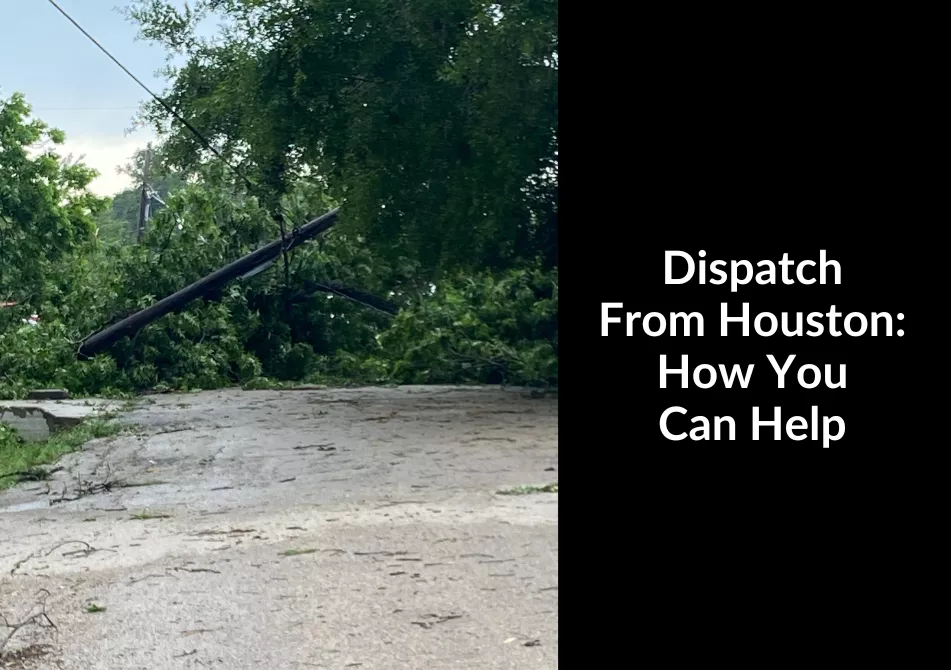
Photo of a fallen tree on a power line in Houston after last Thursday's storm. Courtesy of Dave Cortez.
By Dave Cortez and Matt Johnson
Director and Deputy Director, Sierra Club Lone Star Chapter
The heat dome has returned to Texas and as of Wednesday morning, May 22, more than 190,000 people in the Houston area were still without electricity from the powerful and unexpected storm that blew through last Thursday.
More than likely at some point over the past four years, like millions of Texans, you’ve found yourself without power. Remember the spoiled food in the fridge? The lack of air conditioning or heat? And the growing exhaustion from the anxiety of survival?
There’s no experience like it, and we’d like to work with you to do all we can to help those navigating this latest front line in the worsening climate crisis. At the bottom of this post you’ll see a list of organizations working on the ground to support Houstonians still recovering from last week’s “derecho.” Please give what you can.
Last Thursday night, like many of you, we saw the disaster unfolding on social media. We wouldn’t realize the extent of the damage until our trip to Houston was already underway Friday morning. It was originally supposed to be two days worth of meetings, but we shifted our plans and began gathering up the disaster response tools we’ve learned to use since the Halloween floods in Central Texas, 2021 winter storm grid failure, and 2023 ice storms.

Supplies for residents of Houston's 5th Ward impacted by the derecho storm. Photo courtesy of Dave Cortez.
Batteries. Water. Solar. Scissor jack. Blades. Canned food. Ice. Flashlights. Charging cables. Our breath, calm level heads. Day one of a climate disaster is always shrouded in shock and anxiety. Is my family okay? When will the power come back on? How am I going to charge my phone? How long will the food in my fridge last? How am I going to get through this?
In Katy, TX we stopped to fully charge our EV and stock up on almost $500 worth of supplies for residents of Houston’s 5th Ward identified by CEER (Coalition for the Environment, Equity, and Resiliency) and West Street Recovery as in need of immediate support. All along the way we saw downed trees, trees on homes, traffic lights out, utility poles and wires knocked down, and people on the streets in search of a building with electricity.
In house after house, the people we encountered all had similar thoughts on what just happened. They were shocked by the storm’s unexpected intensity and the damage it caused. This is the climate crisis. More extreme weather causing disproportionate harm to those on the frontlines of poverty, flooding, and aging infrastructure.
Even though the power getting knocked out was bad, there was also a distinct calmness based in familiarity. Hurricanes Harvey and Ike were referenced a number of times while we helped to charge phones that were already running low on power.
After dropping off all the supplies and charging as many phones as we could, we took a look at Centerpoint Energy’s outage map. More than 800,000 were still without power. Mutual aid networks are crucial to survival as we adjust to life in a changed climate. The scope of their work, though, is enormous. Federal, state, and local emergency response efforts can’t meet everyone’s needs in a timely way, and red tape often hinders support.
Please consider donating your time and/or money to support these incredibly important organizations that put people’s needs first during times of emergency:
- West Street Recovery
- Coalition for Environment, Equity and Resilience
- Achieving Community Tasks Successfully/ACTS
- Coalition of Community Organizations/COCO
- East Harris County Empowerment Council
- Environmental Community Advocates of Galena Park
With gratitude and in solidarity to those affected by this storm and those still to come.

Matt Johnson, Houston resident Sandra Edwards, Dave Cortez. Photo courtesy of Dave Cortez.